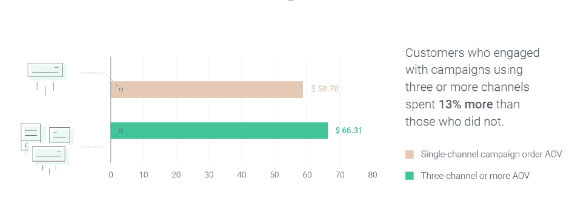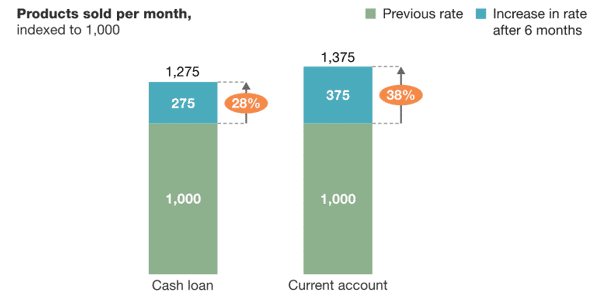Do you find it challenging to engage with your consumers online? Are you doing omnichannel marketing implementation the right way? In order to increase satisfaction, retention, and profitability levels, it is vital to create a seamless experience across the channels where customers interact with your brand.
If done correctly, it can help your business. In fact, 50% of in-store purchases are affected by digital, and the trend is anticipated to grow to 58% by 2022.
In this article, you can learn the 4 steps which you can implement in your Omnichannel marketing strategy to grow your business.
Identifying your ideal customer, choosing communication channels, finding omnichannel marketing software, and preparing the team to work and think in an omnichannel marketing way are effective four steps to assist you in your omnichannel marketing implementation plan.
1. Identify Your Ideal Customer
A successful omnichannel marketing implementation strategy involves learning everything you can about your customers. And for that, you need data which you can gather as you go.
Proceed the following way:
- Overhauling your customer experience: Conduct a full purchase on your site while interacting with all the channels you use. Also, put in a ticket with customer service. Consider hiring external people to assist in evaluating your customer experience.
- Collect customer feedback: You can gather them by asking your customers for feedback at different stages of their journey. Offering surveys and incentives can encourage responses.
Make sure to listen to the feedback that your customers voluntarily offer. If you don’t correct a problem, nothing will get better. In order to be truly customer-centric, you will have to understand your customers needs and how you can help them.
2. Choose Appropriate Communication Channels For Omnichannel Marketing Implementation
Omnichannel marketing can commit your business to provide consistent, on-brand communications across several customer touchpoints no matter where they are in the path to purchase.
You can use both online and offline channels for your omnichannel communication strategy. Mobile apps, social media profiles, SMS campaigns, online reviews, websites, email marketing, and customer service resources are some channels you can try for omnichannel marketing implementation.
When you use a well-executed omnichannel communication strategy, it can roughly translate to a business and create a consistent, easily recognizable, and integrated customer experience across all the channels.
Note that, even if your email marketing, social media and contact center are all doing great, unless they are integrated and providing a consistent experience, they’re not omnichannel.
Every time your customer reaches out to your business, they should get the same impression and experience of your brand.
3. Find Omnichannel Marketing Software
There are several omnichannel marketing software available in the market to help you achieve a successful omnichannel marketing implementation. Study and compare the tools available depending on what you want it to do for you and choose the one that fits your expectations.
For instance, a commerce-focused marketing automation platform is a great engagement tool for omnichannel personalization. Browse recovery applications, on the other hand, can help track your customers’ online browsing behaviors and automatically deliver personalized messages and re-engage them with your brand. It also pushes them to purchase the products they’re considering.
If you use cart recovery applications, they can automate personalized messages to shoppers and help recover revenue which would otherwise lose when your customers put items in their carts, but leave before purchasing.
And by using product recommendations, you can engage shoppers and begin having a more personal conversation. By adding a recommendations engine to your marketing stack, you will be able to send highly personalized product recommendations to customers across all your messages. Choose the best software for your omnichannel marketing implementation.
4. Prepare The Team To Work And Think In An Omnichannel Marketing Way
Start by getting all members of your team on board with your omnichannel strategy. Collaboration is key in order to avoid the “silo effect.”
In fact, a study made by Queens University suggested that 75% of employees said teamwork and collaboration were very important. In another study, 86% of employees and executives said that the lack of collaboration was the main culprit behind workplace failures.
Once you get your team on board, you can put your customer at the center of your strategy so that you can put their data at the center of your customer operations.
It will allow all the members of your team to utilize the data to generate a better experience for the customer.
- Marketers need access to customer’s data so as to send the most appropriate, timely message to the customers.
- The sales team needs the data for recognizing the products that are most in-demand.
- The data will help customer success to maintain a consistent conversation with customers and more.
When your team members know about your customers well, they will be able to respond and interact with them better.
Is Omnichannel the same as multichannel? Which channel is most effective for your Omnichannel marketing implementation plan?
Many think that omnichannel is the same as multichannel as they both have multiple channels that businesses use to communicate with customers.
However, the main difference comes from integration. Both omnichannel and multichannel offer the customers varied ways to access information through channels, but in multichannel marketing, the team doesn’t work together.
So omnichannel vs. multichannel: Which strategy is more effective?
While your customers may still buy through multichannel eCommerce, omnichannel results in more purchases.

As shown in the image above, when customers utilize over three channels, they spend more money. The omnichannel marketing implementation plan pushes them to use other channels as it keeps each channel unified. Customers find it easier to make use of those other channels through an omnichannel strategy. Thus, they utilize them leading to an increase in sales.
In a study, it was found that a regional bank’s product sales were increased with omnichannel marketing by over 25% in six months.

Today’s consumers are all about the experience. In fact, it’s highly likely that customers would be willing to pay more while making purchases if they have a better customer experience. And omnichannel marketing can help you give your customers a better experience.
Winding-Up
When you employ the omnichannel marketing plan, you can offer your users, shoppers, and customers a unified experience. You can expect better user engagement and improved sales and brand awareness.
Omnichannel marketing can help you to effectively integrate different channels, offer users with a unified experience, effortlessly control all your channels, and increase your ROI, build a long-term, sustainable business.
With omnichannel marketing, you will be able to take your online store from a regular business to a sales-driven business that can set up and grow its customer base over time.
When you are omnipresent on the channels that your customers spend their time, and when you get your entire brand behind crafting an omnichannel experience, you can give your customers the best experience which will set you apart from your competition.
Also, make sure you appropriately collaborate with your team. For that, you can try Runrun.it, a collaboration tool to keep your team motivated and communication transparent.
It will also help to keep your workflow smooth. Even big brands like Amazon use omnichannel marketing and have found success. You could be next!
